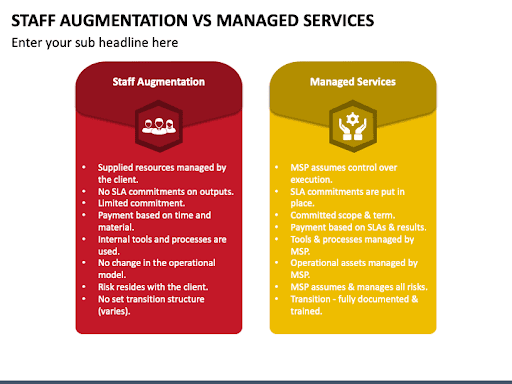IT hiring is in massive turmoil right now. Projects piling up, deadlines feel too stressful, and let’s be real—searching for the right talent is more complicated than ever. The question is, do you bring in additional hands to support your team temporarily, or do you offload your IT workload to a third-party provider and let them handle everything?
This is where the staff aug vs managed services debate comes into the picture. It is not simply about getting work done—it is about ownership, flexibility, budget, and long-term planning. Choose the wrong model, and you could end up with unnecessary costs, delays, and frustration. Choose wisely, and you will have a smooth-running IT operation that supports your business growth.
So, when should you hire IT talent through IT staff augmentation services, and when is managed services the better option? Let’s break it down.
Overview of IT Service Models
There are two main ways businesses bring in IT expertise:
- Staff augmentation: You hire remote talent for a specific project or skill gap, but they work as part of your in-house team. You keep full control over the project.
- Managed services: You outsource your IT function to a provider who takes full responsibility for managing it, freeing up your internal team.
Understanding Staff Augmentation
Staff augmentation is when you bring in outside IT professionals for a short time to help your existing team. A different company employs these professionals, but they easily blend in with your team and work alongside them.
Key Features of Staff Augmentation
- Quick access to top talent without the hassle of full-time hiring.
- Scalability—expand or reduce your workforce based on demand.
- Full project control—external hires work under your management.
- Cost-effective—you pay only for the talent you need when you need it.
When to Choose Staff Augmentation
- You need specialized IT skills for a short-term project.
- Your internal team is stretched thin, and you need immediate support.
- You want to retain full control over project execution.
- You are looking for a flexible, budget-friendly approach without committing to full-time hires.
Understanding Managed Services
Managed services involve outsourcing IT operations to a third-party provider. Instead of hiring temporary staff to support your team, they will help to hire experienced IT talents and takes full responsibility for managing and maintaining the talents.
Key Features of Managed Services
- Comprehensive IT support covering security, infrastructure, and cloud management.
- Predictable costs with fixed pricing models.
- Proactive monitoring, preventing IT issues before they happen.
- Reduced internal workload, freeing up your team for strategic initiatives.
When to Choose Managed Services
- You need long-term IT support and want to outsource the burden.
- Your IT infrastructure is complex, and you need expert management.
- You want to focus on business growth while leaving IT to the experts.
- You prefer fixed, predictable IT costs instead of fluctuating expenses.
Key Differences Between Staff Augmentation and Managed Services
Here’s a quick sneak peek of staff aug vs. managed services:
Factor | Staff Augmentation | Managed Services |
Control | You manage the team and execution | Provider takes full responsibility |
| Cost Structure | Flexible, pay-as-you-go | Fixed monthly or annual pricing |
Scalability | Highly adaptable, scale up or down anytime | Less flexible, long-term agreements |
| Expertise | Fills skill gaps for short-term needs | Covers full IT functions on an ongoing basis |
Making the wrong choice can lead to wasted money, inefficiencies, and resurfacing IT problems.
When to Choose Staff Augmentation

- You need specialized skills, fast. Tech talent is hard to find—83% of IT leaders say they struggle with hiring. Staff augmentation gives you access to experts without a long recruitment process.
- Your project is short-term. If you just need help for a few months, hiring full-time employees makes no sense.
- You want full control. You know how your IT projects should be run. With staff augmentation, external hires work under your management.
- You are watching your budget. Pay only for the talent you need—no unnecessary overhead.
When to Choose Managed Services
- You need a long-term IT partner. 60% of companies outsource IT so they can focus on their core business.
- Your IT needs are ongoing. If cybersecurity, cloud management, or IT infrastructure require constant attention, a managed services provider is a smarter choice.
- You want less management hassle. Instead of worrying about IT, let an external provider handle it.
- You need predictable costs. Fixed pricing models help you avoid budget surprises.
Pros and Cons of Staff Augmentation
Pros
- Fast access to skilled professionals—no long recruitment process
- More cost-effective than full-time hiring—only pay for what you need
- Full control over project execution
- Scalable workforce—add or remove resources as needed
Cons
- Requires internal management and oversight.
- Not ideal for long-term IT needs—constant hiring may be required.
Pros and Cons of Managed Services
Pros
- Comprehensive IT support—no internal management needed.
- Proactive issue prevention—reduces downtime and security risks.
- Predictable costs—fixed pricing helps with budgeting.
- Access to the latest technologies and best practices.
Cons
- Less control over IT decisions—provider makes most technical calls.
- Long-term contracts can limit flexibility.
- Higher upfront costs compared to staff augmentation.
How to Decide: Staff Augmentation vs. Managed Services
Choosing between IT staff augmentation services and managed services comes down to:
- Project scope: If you need extra hands for a short-term project, staff augmentation is your best bet. If you need ongoing IT management, go with managed services.
- Budget flexibility: If you prefer cost efficiency, hiring IT talent through staff augmentation keeps expenses low. If you want predictable IT costs, managed services are better.
- Level of control: If you want to oversee execution yourself, staff augmentation makes sense. If you prefer a hands-off approach, managed services are the way to go.
Conclusion
Choosing between staff augmentation and managed services depends on your project needs, budget, and how much control you want over your IT operations.
- Need temporary, flexible IT support? Staff augmentation is the way to go.
- Need long-term IT stability and minimal management effort? Managed services are a better fit.
- Can’t decide? Some companies use a mix of staff augmentation for projects and managed services for ongoing IT needs.
Choosing the correct option is more than just hiring someone—it’s about using IT to benefit your business. Make a smart decision, and your IT plan will help your company grow instead of hindering its progress.















